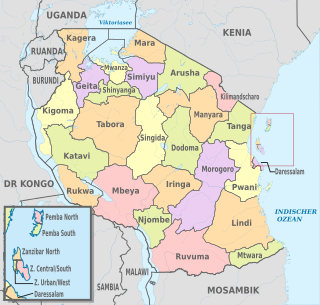
Dar es Salaam (Dar) is the former capital as well as the most populous city in Tanzania and a regionally important economic centre. Located on the Swahili coast, the city is one of the fastest growing cities in the world.
This article is about the demographic features of the population of Tanzania, including population density, ethnicity, education level, health of the populace, economic status, religious affiliations, and other aspects of the population.
Telecommunications in Tanzania include radio, television, fixed and mobile telephones, and the Internet available in mainland Tanzania and the semiautonomous Zanzibar archipelago.

Zanzibar is a semi-autonomous region of Tanzania. It is composed of the Zanzibar Archipelago in the Indian Ocean, 25–50 kilometres (16–31 mi) off the coast of the mainland, and consists of many small islands and two large ones: Unguja and Pemba Island. The capital is Zanzibar City, located on the island of Unguja. Its historic centre is Stone Town, which is a World Heritage Site.

Dodoma, officially Dodoma City, is the national capital of Tanzania and the capital of Dodoma Region, with a population of 410,956.

East Africa or Eastern Africa is the eastern region of the African continent, variably defined by geography. In the United Nations Statistics Division scheme of geographic regions, 20 territories make up Eastern Africa:

Tanzania is divided into thirty-one regions or mikoa.

Namanga is a town divided by the Tanzania-Kenya border. It is in Longido District, Tanzania and Kajiado County, Kenya. It is around 110 kilometers from Arusha, Tanzania. Namanga's economy has been heavily dependent on tourism since 2004 as tourists visiting the nearby Amboseli National Park passed through the town from Nairobi which is 183 kilometers from Namanga. The town is surrounded by hills from both the Tanzanian side and Kenya. Mount Kilimanjaro can be viewed from Namanga town which makes it a scenic place by tourists who lodge in Namanga on their way to either Tanzania or Amboseli. The nearby Ol Doinyo Orok mountain, also known as Namanga Hills is located northwest of Namanga town. Namanga's latitude is S 2°32'39.8" and longitude E 36°47'20.2". The town has an urban population of approximately 10,000 while the rural population is approximately 5,500.

The Ngorongoro Conservation Area is a protected area and a World Heritage Site located 180 km (110 mi) west of Arusha in the Crater Highlands area of Tanzania. The area is named after Ngorongoro Crater, a large volcanic caldera within the area. The conservation area is administered by the Ngorongoro Conservation Area Authority, an arm of the Tanzanian government, and its boundaries follow the boundary of the Ngorongoro Division of the Arusha Region.

Dodoma Region is one of Tanzania's 31 administrative regions. The regional capital is the city of Dodoma. According to the 2012 national census, the region had a population of 2,083,588, which was lower than the pre-census projection of 2,214,657. For 2002-2012, the region's 2.1 percent average annual population growth rate was the twentieth highest in the country. It was also the seventeenth most densely populated region with 50 people per square kilometer. The main tribes of the region are the Gogo, the Warangi, and the Wasandawi; Dodoma means "sunk" in the Gogo language.

Pwani Region is one of Tanzania's 31 administrative regions. The regional capital is the town of Kibaha. According to the 2012 national census, the region had a population of 1,098,668, which was slightly lower than the pre-census projection of 1,110,917. From 2002 to 2012, the region's 2.2 percent average annual population growth rate was the seventeenth-highest in the country. It was also the 21st most densely populated region with 34 people per square kilometer. With a size of 32,407 square kilometres (12,512 sq mi), the region is slightly larger than the U.S. state of Maryland.

Unguja is the largest and most populated island of the Zanzibar archipelago, in Tanzania.

The Ndali are an ethnic and linguistic group from Mbeya Region, Tanzania and northern Malawi. In 1987 the Ndali population of Tanzania was estimated to number 150,000, and in 2003 the population in Malawi was estimated at 70,000, for a total for the group of about 220,000. Their language is related to many Bantu languages, for example Nyakyusa.

The Iraqw or Irakw are a Cushitic-speaking ethnic group inhabiting the Great Lakes region of East Africa. They live in the Arusha and Manyara regions of north-central Tanzania, near the Rift Valley wall and south of Ngorongoro Crater.

Islam one of the 2 major religions in Tanzania. There are no reliable statistics, figures claimed vary between 35% and 55% of the people of Tanzania. On the mainland, Muslim communities are concentrated in coastal areas, with some large Muslim majorities also in inland urban areas especially and along the former caravan routes. More than 99% of the population of the Zanzibar archipelago is Muslim. The majority of Muslims in Tanzania are Sunni of Shafi school of jurisprudence, with unusually significant Shia and Ahmadi minorities in sub-Saharan Africa. According to Pew research center, two-thirds of the Muslim population of Tanzania is Sunni, while the rest is either Shia (20%) or Ahmadi (15%).

Christianity is the largest religion in Tanzania according to the most recent estimates. There are also substantial Muslim and Animist minorities.
Tanzania is a multilingual country. There are many languages spoken in the country, but no one language is spoken natively by a majority or a large plurality of the population. The Bantu Swahili language and English, the latter of which was inherited from colonial rule, are widely spoken as lingua francas. They serve as working languages in the country, with Swahili being the official national language. There are more speakers of Swahili than of English in Tanzania.
Tanzanian Americans are Americans of Tanzanian descent. In the 2000 US Census, 2,921 people reported Tanzanian ancestry. To this figure we must adhere some people that hailed be of "Tanganyika" and "Zanzibar Islanders" descend. Between 2009-2011 were registered 20,308 Tanzanians living in United States.















